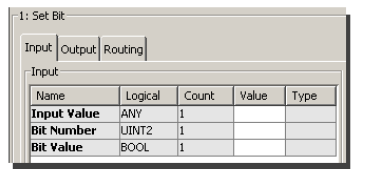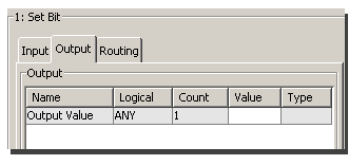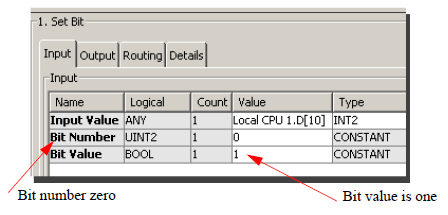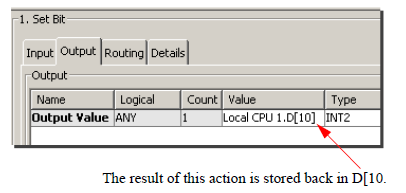The Set Bit action sets the value of a
bit in a variable.

Input tab
| Parameter | Description |
|---|---|
| Input Value | The name of the source variable
whose bit you want to set. The input variable can be of any data type. However, a STRING variable should not be used as the length of the string is embedded in the first 4 bytes. The result of the Set Bit action is copied from the internal replica of the source variable to the destination array. If you want to update a source varaiable directly with the bit value specified, then the Output tabOutput Value parameter should be set to the same device variable as the Input tab Input Value parameter. |
| Bit Number | The position of the bit in the input variable, where 0 is the low-order bit position. |
| Bit Value | The value to set into the bit at
position Bit Number.
This can be a any type of
variable. For a Constant:
|
Output tab
The Output tab provides the means to
set one bit in an integer. You can only set one bit per
Set Bit action.

The Output tab provides three rows to set values for Set Bit.
| Parameter | Description |
|---|---|
| Output Value | Specifies the destination variable
to place the result of the Set
Bit action. The result of the Set Bit action is copied from the internal replica of the source variable to the destination array. If you want to update a source variable directly with the bit value specified, then the Output tab Output Value parameter should be set to the same device variable as the Input tabInput Value parameter. |
Example Set Bit
You can use the Set Bit action in a trigger to set a bit in an integer variable (such as INT2). Since an INT2 (or WORD) represents a 2-byte data field, bit 0 always represents the least significant bit, and bit 15 represents the most significant bit.
The example Input tab shows how to set
bit number zero in D[10] to the value one.

The Output tab is used to store the
result of this action.

Note that the other bits in D[10] are not affected by
this operation. They retain their values from before the
action. In other words, bits 1 through 15 remain
unchanged.